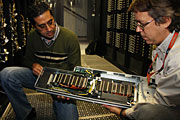- Number 356 |
- February 13, 2012
Scientists build GPU cluster for subatomic calculations

Fermilab’s Amitoj Singh and
Don Holmgren examine one of
the new GPUs used for lattice
QCD calculations.
Photo: Brad Hooker
The latest addition to computing power at DOE’s Fermi National Accelerator Laboratory is a 45-teraflop cluster of graphics processing units that scientists use to explore the properties of the strong nuclear force. The GPU nodes power through data faster than any other computing nodes at more than five times the rate of the processing units of the previous generation.
The cluster is part of a national project called USQCD. Quantum chromodynamics, or QCD, is the theory that explains the properties and behavior of quarks and gluons. Scientists compute the particles’ subatomic interaction, the strong nuclear force, using algorithms and techniques known as lattice QCD. The USQCD collaboration develops the software and hardware needed to meet the high demands of lattice QCD calculations, which require tens of thousands of processors.
While industry would like to see increasingly powerful processors applied to cell phones, laptops and other consumer electronics, the USQCD collaboration aims to determine how important GPUs will be to scientific computing.
"We don't know if GPU-like chips are the way of the future or just a flash in the pan now," said Fermilab physicist Paul Mackenzie, spokesman for the national collaboration of QCD, in a recent interview. "The scientific computing world is changing. Computers 10 years from now will look very different from how they've looked the last 10 years."[Kurt Riesselmann, 630-840-3351,
kurtr@fnal.gov]
